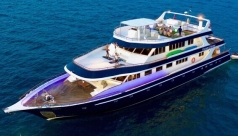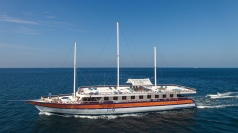Addu Atoll
Addu (aka Seenu) is the second largest urbanisation and the southernmost atoll in the Maldives. There are over 30 world class dive sites surrounding the atoll, on the outer walls, in wide channels, and healthy reefs and thilas inside the lagoon. The sites are renowned for their excellent visibility. Highlights of diving in Addu include year round manta rays, turtles, sharks, big fish, and the largest wreck in the Maldives. Due to its remote location, its reefs are among the best in the country and have famously avoided the effects of coral-bleaching so far. Most of the sites here are deep, making this Maldives Deep South destination ideal for advanced divers.
Addu’s most famous dive site is the British Loyalty shipwreck, located in the inner lagoon. The British Loyalty was a 135m long oil tanker, built in Newcastle in 1928 and that was operative during World War II. It was damaged in Madagascar in 1942 by a torpedo from a Japanese submarine. The British forces decided to relocate the tanker to Addu Atoll for use as storage. However, despite the use of anti-submarine nets that can still be seen at the atoll, the Loyalty was hit again in 1944, this time by a German submarine. Although the tanker did not initially sink, it was finally scuttled in 1946 and now lies on its starboard side at 33m near Gan.
Hard and soft coral growth is substantial and the Loyalty wreck normally attracts turtles, bluefin trevally and sharks, and harbours fish such as parrotfish, sweetlips and snappers. 2 giant holes: can be seen in the hull in front of the engine room - one on the deck side and one in the keel. The holes are so large that scuba divers can swim through from one side to the other. The propeller lies at 28m, and its 2m long blades are covered in large black coral bushes. The shallowest portion of the port side hull is at a depth of 15m and can be seen from the surface.
The outer walls feature vertical walls adorned with pink and blue gorgonians, and gentle slopes with incredible hard coral structures down to 30m. The walls are often marked with large caverns and overhangs where you can find green and hawksbill turtles, mantis shrimps, lobsters, whitetip reef and nurse sharks resting. Large pelagics are often present in the blue, such as sailfish, dogtooth tuna, silvertips and oceanic mantas, and the occasional tiger shark. Curious schools of batfish, fusiliers and jackfish are almost always found here. Strong currents can be present, meaning these sites are often drift dives. Swells can be present during windy periods.
There are 4 natural channels (known as “kandus”) that link the turquoise waters of the inner lagoon to the open ocean through the outer atoll walls. These represent some of the best scuba diving opportunities at Addu Atoll. The channels are wider than elsewhere in the Maldives, meaning that currents are not so strong and hard coral life has the opportunity to flourish and grow in to spectacular coral formations, with huge table, brain, elkhorn, cone and mushroom corals. The channels are popular spots to see schooling fish, Napoleon wrasse, turtles, and for grey reef sharks to prowl.
One of the best channel dives is Maa Kandu Channel. Here you can find Mudakan Manta Point, one of Addu’s top dive sites. Up to 30 reef mantas have been seen on a single dive here. Hook on to the reef at 20-25m to combat the current, then relax and enjoy the show as these graceful rays glide in and out of your vision. Manta rays are highly intelligent and curious and will often come very close. Scuba divers can enjoy the mantas of Addu all year round. On an outgoing tide, the water will sweep you out on to the outer wall. You will pass large groups of grey reef sharks, eagle rays and Napoleon wrasse. The outer wall at 30m is where you have the chance of highly-prized encounters with hammerheads, bull sharks and even tigers.
Fuvahmulah Island
The waters that surround this island are what have really earned the Maldives Deep South its reputation for top class diving. Experienced divers from all around the world make the long journey here for the promise of spectacular interactions with some of the world’s top predators, such as tigers sharks, threshers, hammerheads, silvertips, oceanic whitetips and whale sharks. The island is also a hotspot for oceanic giant mantas that come here each March-May to mate. The island’s exposure to the deep Indian Ocean also mean that you have a very good chance to see something out of the ordinary such as sailfish, mola-mola, or large schools of tuna. Even pilot whales and humpbacks are known to visit. Altogether, Fuvahmulah is one amazing dive destination for lovers of megafauna.
> [More details:
Fuvahmulah Island]
Huvadhoo Atoll
Huvadhoo (northern part known as Gaafu Alifu, southern part known as Gaafu Dhaalu, separated by the Huvadhu Channel) is the second largest atoll in the Maldives (65 km across at its widest point. It consists of a circular ring of reefs that surround the edge of the atoll and which enclose a 85m deep central lagoon, full of thilas and shallow reefs that surround more than 200 islets. The ring of reefs is broken by 40 deep channels that connect the lagoon to the open ocean. These passages provide plenty of exhilarating diving where dolphins, reef sharks and larger fish can be encountered.
There are many caverns and tunnels to explore around the islets of the central lagoon, where you can find cowtail and whiptail rays, plenty of turtles, garden eels, guitar sharks, leopard and nurse sharks. The reefs are composed mostly of hard coral species such as porites and layered table corals, and are patrolled by grey reef sharks, blacktip reef sharks, and bigmouth mackerel. Napoleon wrasse and schools of blue-striped snapper are found in abundance. The macro life is particularly good here, and you can focus your sights on discovery critters such as flatworms, shrimps, and scorpion leaffish.
One of the most famous lagoon sites is Hafsa Thila, which is a great place to watch trevally and dogtooth tuna hunting baitfish, blue chromis, and enormous swarms of anthias around the steeply sided pinnacle. Look in the reef to find ribbon eels, fire gobies, stonefish, and the endemic Maldivian anemonefish. In the blue you can see mobula rays, batfish, oceanic triggerfish and rainbow runners.
Bluefin trevally, barracuda, tuna, and enormous schools of fusiliers are found along the outer reef walls and channels, as well as occasionally great hammerheads, oceanic blacktips, silkies, sunfish, bull and tiger sharks. Huvadhoo is famed for its night dive encounters with whale sharks. Nilandhoo Kandu is one of the most famous channels where dense schools of bigeye trevally, surgeonfish and big grouper species hang out. Divers are often joined on safety stops by playful spinner dolphins.



































